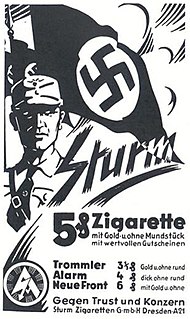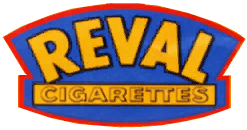West is a German brand of cigarettes, currently owned and manufactured by Imperial Brands.

Kretek are unfiltered cigarettes of Indonesian origin, made with a blend of tobacco, cloves, and other flavors. The word "kretek" itself is an onomatopoetic term for the crackling sound of burning cloves.

Reemtsma Cigarettenfabriken GmbH is one of the biggest tobacco and cigarette manufacturing companies in Europe and a subsidiary of Imperial Brands. The company's headquarters is in Hamburg, Germany.
Doral is an American brand of cigarettes, currently owned and manufactured by the R.J. Reynolds Tobacco Company.

Herbal cigarettes are cigarettes that usually do not contain any tobacco or nicotine, instead being composed of a mixture of various herbs and/or other plant material. However, Chinese herbal cigarettes contain tobacco and nicotine with herbs added, unlike European and North American herbal cigarettes which have tobacco and nicotine omitted. Like herbal smokeless tobacco, they are often used as a substitute for standard tobacco products. Herbal cigarettes are often advertised as a smoking cessation aid. They are also used in acting scenes by performers who are non-smokers, or where anti-smoking legislation prohibits the use of tobacco in public spaces. Herbal cigarettes can carry carcinogens.

Next is a brand of cigarettes, currently owned and manufactured by Philip Morris International. The original acronym for Next was a reference to "nicotine extracted".

f6 is a German cigarette brand owned by Philip Morris International and produced by the f6 Cigarettenfabrik Dresden GmbH.
(or King's Favourites) is a Danish brand of cigarettes owned by conglomerate British American Tobacco, and produced by House of Prince.

The Sturm Cigarette Company was a cigarette company created by the Nazi Party's Sturmabteilung (SA). The sale of its cigarettes provided the SA with operating funds and a channel for political messaging. Coercion and violence were used to increase sales.
Cambridge is a brand of cigarettes, currently owned by conglomerate Altria, and manufactured by Philip Morris International. In the U.K., Cambridge was manufactured by Rothmans International until 1999.

Peter Stuyvesant is a brand of cigarettes currently owned by British American Tobacco and manufactured by the American Cigarette Company. In Australia and New Zealand, the brand is manufactured by Imperial Tobacco. The cigarette brand is named after Petrus Stuyvesant, Director General of New Netherland, later New York State, New Jersey, Delaware and parts of surrounding states.

Atika is a German cigarette brand which was owned and manufactured by Reemtsma, a subsidiary of Imperial Tobacco. Production of cigarettes under the "Atika" brand was discontinued in 2016.
Cabinet is a German brand of cigarettes, currently owned and manufactured by Reemtsma, a subsidiary of Imperial Brands. It is mainly sold and found in the New states of Germany.

Eckstein No. 5 was the oldest still existing German brand of cigarettes which was owned by Reemtsma, a subsidiary of Imperial Tobacco

Kim was a German brand of cigarettes that was manufactured by British American Tobacco.

Overstolz is a German cigarette brand manufactured by Japan Tobacco International.

R6 is a German brand of cigarettes, currently owned and manufactured by Reemtsma, a subsidiary of Imperial Brands.

Reval is a German brand of cigarettes, currently owned and manufactured by Reemtsma, subsidiary of Imperial Tobacco.
Senoussi was a German brand of cigarettes that was owned and manufactured by Reemtsma, a division of Imperial Tobacco.

Black Devil is a Dutch brand of cigarettes, currently owned and manufactured by Heupink & Bloemen. The brand is especially popular amongst teen smokers.
















